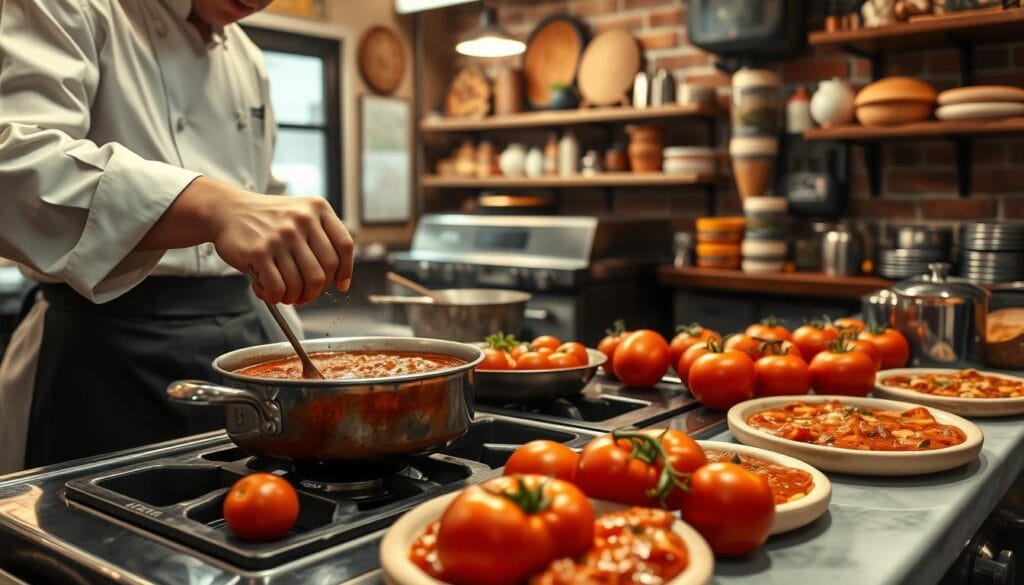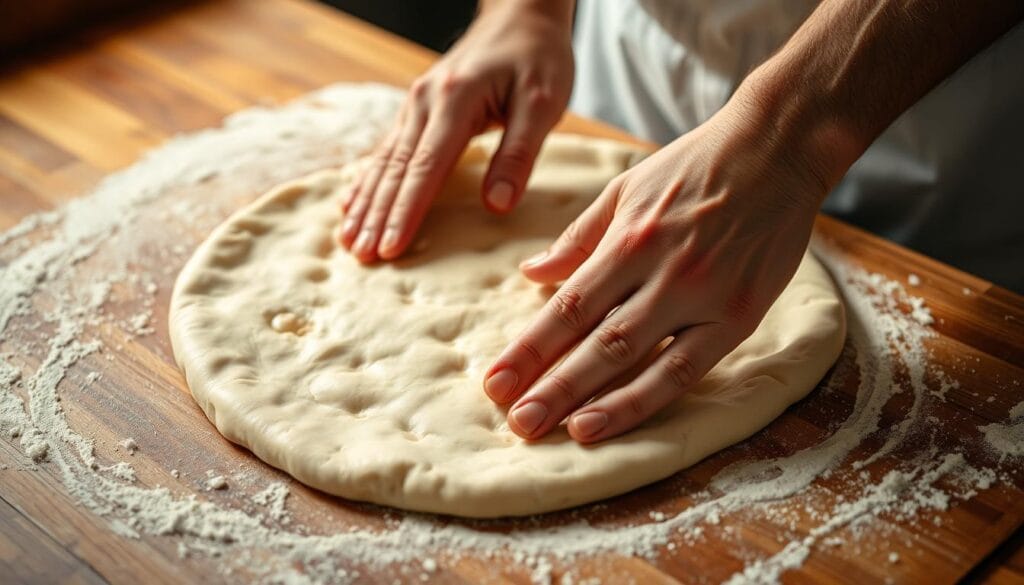Want to make the ultimate homemade NY pizza? You’re starting a tasty adventure into authentic New York pizza. From the crispy crust to the perfect cheese, making NY pizza at home is an art. It turns your kitchen into a classic pizzeria.
Making homemade NY pizza is more than just ingredients. It’s about capturing New York’s iconic culinary treasure. Whether you love pizza or want to master an authentic NY pizza recipe, this guide will help. You’ll learn how to make the perfect slice.
Key Takeaways
- Learn the secrets behind authentic New York pizza techniques
- Understand the critical components of a perfect NY slice
- Master home pizza-making skills like a professional
- Discover the unique characteristics of NY-style pizza
- Transform your kitchen into a local pizzeria
The History Behind Authentic New York-Style Pizza
The story of NY pizza is a tasty journey through Italian-American cuisine. It started in the early 20th century. Italian immigrants brought their cooking traditions to New York City, changing American food forever.
The roots of NY pizza come from Naples, Italy. There, traditional thin crust pizza was born. Italian immigrants made it their own, creating the famous New York slice.
The Italian-American Pizza Transformation
New York pizzerias became cultural spots in immigrant areas. They changed how Americans saw pizza. They introduced a unique style with:
- Large, thin and crispy crust
- Wide, foldable slices
- Simple yet flavorful ingredients
- Quick service style
Evolution of the Famous NY Slice
The NY pizza slice became a street food hit. It was affordable, easy to eat, and tasty. It matched New York City’s fast pace.
“A true NY slice is more than food – it’s a cultural experience” – Pizza Historian
What Makes NY Pizza Unique
Several things make authentic NY pizza stand out:
| Characteristic | Description |
|---|---|
| Crust | Ultra-thin, crispy yet flexible |
| Size | Large 18-inch diameter |
| Cheese | Low-moisture mozzarella |
| Sauce | Light, tangy tomato base |
Knowing the rich history of NY pizza helps us love it more. From immigrant kitchens to worldwide fame, the NY slice shows the heart of Italian-American cuisine.
Essential Equipment for Making NY Pizza at Home
Making authentic New York-style pizza is more than just using great ingredients. The right tools can turn your kitchen into a pizzeria. Specialized equipment is key to getting that crispy crust everyone loves.
Your home pizza oven and stone are crucial for making pizza. A good pizza stone spreads heat evenly, like a traditional brick oven. Ceramic or cordierite stones are best for a crispy bottom.
- Pizza Stone: Essential for even heat distribution
- Pizza Peel: Helps transfer pizza in and out of the oven
- Digital Kitchen Scale: Precise ingredient measurements
- High-Temperature Oven Thermometer: Ensures perfect cooking conditions
For those on a budget, start with versatile tools. A cast-iron skillet can be a great pizza surface. It holds heat well, just like a stone.
| Tool | Purpose | Estimated Cost |
|---|---|---|
| Pizza Stone | Create crispy crust | $30-$100 |
| Pizza Peel | Easy pizza transfer | $20-$50 |
| Digital Scale | Precise ingredient measurement | $15-$40 |
Great equipment doesn’t make perfect pizza. Practice and passion are more important. Start with basics and upgrade as you get better.
Understanding the Perfect NY Pizza Dough
To make a real NY pizza dough, you need to be precise and know the right ingredients and methods. Your first step is to learn how to prepare the dough well.
The base of a great NY pizza dough is the flour. High-gluten flour is key for that chewy texture. Bakers know that the flour’s protein content is what makes the dough work.
High-Gluten Flour Selection
For your NY pizza dough, pick flour with 12-14% protein. This type of flour makes the dough stretchy and crisp.
- King Arthur Bread Flour (12.7% protein)
- All Trumps High Gluten Flour (14% protein)
- Caputo Pizzeria Flour (13% protein)
Water Temperature and Chemistry
The water’s temperature is important for yeast and gluten. Use water between 95-105°F for the best results.
| Water Temperature | Yeast Activation | Dough Outcome |
|---|---|---|
| Below 70°F | Slow | Underdeveloped |
| 95-105°F | Optimal | Perfect Rise |
| Above 120°F | Killed | No Rise |
Proper Fermentation Techniques
Fermentation turns simple ingredients into a flavorful base. Cold fermentation, which takes 24-72 hours in the fridge, adds depth. It makes the dough taste like a real NY pizza.
Learning these methods will make your homemade pizza amazing. It will bring the taste of New York pizzerias to your kitchen.
I Love NY Pizza: Mastering the Classic Sauce

Making the perfect NY pizza sauce is an art. It begins with the right ingredients. San Marzano tomatoes are key, offering a rich flavor and low acidity. They turn a simple sauce into something special.
Your techniques for NY pizza sauce are crucial. The secret is simplicity. Traditional pizzerias use high-quality ingredients that speak for themselves.
- Choose San Marzano tomatoes for the most authentic taste
- Use fresh basil for added aromatics
- Avoid overcooking to maintain bright tomato flavor
- Season sparingly with salt and a touch of garlic
Many home cooks wonder if to cook the sauce or use it raw. For a true NY-style pizza, most say to cook it lightly. This blends the flavors while keeping the tomatoes fresh. The sauce should be smooth and not too runny or thick.
When putting sauce on your pizza, remember: less is more. A thin layer lets the crust and toppings stand out. About 1/4 cup of sauce per 12-inch pizza is just right.
Selecting the Right Cheese for Your NY Pizza
Making the perfect New York-style pizza begins with choosing the right cheese. The right cheese can turn a simple slice into a memorable dish. Your cheese choice affects the pizza’s taste, texture, and how true it tastes to a real NY pizza.
Cheese is key to getting that classic NY pizza look and taste. Professional pizza makers know that not all cheeses are good for pizza.
Low-Moisture Mozzarella: The Pizza Champion
Low-moisture mozzarella is the top choice for authentic NY-style pizza. It offers several benefits:
- Creates a smooth, even melt
- Prevents too much moisture on the pizza
- Gives that classic stretchy texture
- Keeps the pizza’s shape during baking
Mastering Cheese Blending Techniques
Experts often mix cheeses to add depth to flavors. Here are some top cheese blends:
| Cheese Blend | Flavor Profile | Recommended Ratio |
|---|---|---|
| Mozzarella + Provolone | Rich, slightly sharp | 70% Mozzarella, 30% Provolone |
| Mozzarella + Parmesan | Tangy, nutty undertones | 80% Mozzarella, 20% Parmesan |
| Mozzarella + Pecorino | Bold, salty kick | 75% Mozzarella, 25% Pecorino |
Try these cheese blends to find your favorite. The goal is to add to the pizza’s taste without overpowering it.
Stretching and Shaping Your Pizza Like a Pro

Mastering pizza dough stretching is an art form. It sets apart amateur cooks from true pizzaiolos. The key to creating an authentic hand-tossed pizza is understanding the delicate process of transforming a simple ball of dough into a perfect NY pizza shape.
Before you begin, ensure your dough has rested at room temperature for at least 30 minutes. This allows the gluten to relax, making pizza dough stretching much easier and preventing unexpected tears.
- Start with a well-floured surface
- Gently press the dough into a flat disk
- Use your knuckles to stretch the dough
- Rotate the dough continuously for even stretching
Professional pizza makers use several techniques for creating the ideal NY pizza shape. Gravity is your friend – allow the dough to hang and stretch naturally, using gentle hand movements to maintain an even thickness.
| Technique | Key Benefits |
|---|---|
| Hand Stretching | Maintains dough’s air bubbles |
| Knuckle Stretching | Prevents excessive handling |
| Hanging Method | Creates thin, even crust |
Common challenges like dough shrinkage can be minimized by letting the dough rest between stretching attempts. If the dough resists stretching, let it sit for a few minutes to relax the gluten, then try again with gentle movements.
The secret to perfect hand-tossed pizza is patience and practice!
Temperature Secrets: Getting That Perfect Crispy Crust
Getting a crispy pizza crust is an art. It starts with knowing the right oven temperature. The perfect heat turns a simple pizza into a New York-style gem, just like your favorite pizzeria.
To make the perfect crust, you need precision and the right tools. Your home oven can be a pizza-making machine with a few tricks:
- Preheat your oven to the highest temperature (usually 500-550°F)
- Let it heat up for 45-60 minutes
- Put your baking surface in the top third of the oven
Oven Preparation Methods
The key to a crispy crust is intense heat. Professional pizza makers use special methods to get the best results:
- Broiler Method: Switching between bottom and top heat makes the crust amazing
- Preheat your baking surface for at least an hour
- Use cooking surfaces that conduct heat well
Baking Stone vs. Steel Comparison
Choosing between a baking stone and steel is important. Here’s what you need to know:
| Baking Stone | Baking Steel |
|---|---|
| Ceramic material | Solid metal construction |
| Slower heat transfer | Rapid, even heat distribution |
| Less expensive | Higher heat retention |
Baking steel is better for a crispy crust. Its fast heat transfer makes the base perfect every time.
Conclusion: Your Journey to Perfect Homemade NY Pizza
Making authentic NY-style pizza at home is an art that needs patience and practice. Your journey starts with understanding that each slice is a culinary adventure. Mastering pizza-making means combining technique and creativity in your kitchen.
The way to NY pizza perfection is through experimenting with ingredients, techniques, and equipment. Your dough, sauce, and cheese choices will change as you get better. Remember, professional pizzaiolos spent years perfecting their craft, so don’t get discouraged by early attempts.
With consistent practice, you’ll go from a novice to a skilled home pizza maker. Spend time learning how to stretch dough, understand oven temperatures, and pick high-quality ingredients. Your hard work will lead to delicious slices that compare to New York pizzerias.
Every pizza you make will deepen your love for this beloved culinary tradition. Share your creations with friends and family, ask for feedback, and keep exploring the world of homemade NY-style pizza. Your kitchen is now your own pizzeria, ready to serve up authentic, tasty slices.
FAQ
What makes New York-style pizza different from other pizza styles?
New York-style pizza has a thin, crispy crust that’s still flexible. It’s covered in generous cheese and simple tomato sauce. The large, wide slice is sold by the slice and eaten folded in half.
Do I need special equipment to make NY-style pizza at home?
While not necessary, a pizza stone or steel and a pizza peel can help a lot. These tools make the crust crispy by providing even heat. They also make it easier to move your pizza in and out of the oven.
What type of flour is best for NY pizza dough?
High-gluten flour (around 13-14% protein content) is best for NY pizza. It gives the dough a chewy texture and a crispy yet pliable crust.
How important is cheese selection for NY-style pizza?
Low-moisture mozzarella is key for authentic NY pizza. It melts well, stretches right, and adds classic flavor. Many use a mix of mozzarella and provolone for extra taste.
Can I make NY-style pizza in a regular home oven?
Yes, you can! Preheat your oven to 500-550°F. Use a pizza stone or steel to mimic a commercial oven. The broiler can help get that crispy crust.
What’s the secret to stretching pizza dough correctly?
Let your dough warm up to room temperature. Use gentle hand-stretching. Avoid rolling pins, which can make the crust tough. Stretch the dough with your hands for a thin, even circle.
How much sauce should I use on a NY-style pizza?
Use a thin layer of sauce. It should cover the dough but not overwhelm it. This way, you can see the dough through the sauce, keeping the crust crispy.
What’s the ideal way to eat a New York pizza slice?
Fold the slice in half lengthwise. This supports the large, thin slice. It’s the classic New York way to eat pizza while walking.


